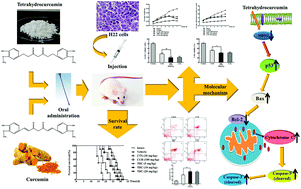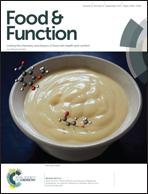Tetrahydrocurcumin is more effective than curcumin in inducing the apoptosis of H22 cells via regulation of a mitochondrial apoptosis pathway in ascites tumor-bearing mice†
Abstract
Curcumin (CUR), a widely used food additive, is derived mainly from Curcuma species that has been applied traditionally for the treatment of various diseases, including hepatocellular carcinoma (HCC). However, its poor systemic bioavailability hampers its clinical application, which may be related to its wide metabolism. Tetrahydrocurcumin (THC) is a major metabolite of CUR and has been reported to have multiple biologic activities. We investigated, for the first time, the efficacy and associated mechanism of action of THC and CUR in a H22 ascites tumor-bearing model in mice. THC evoked a significant dose-dependent promotion of survival and was significantly more effective than CUR in inhibiting tumor growth, including increased body weight, abdominal circumference, ascites volume, and the viability of cancer cells. Experiments on essential immune organs indicated that THC had a more favorable margin of safety than the reference drug cyclophosphamide. THC induced the apoptosis of H22 cells obviously by increasing the level of p53 and decreasing the level of murine double minute 2. THC also decreased the expression of Bcl-2 significantly and increased the expression of Bcl2-associated X, resulting in the release of cytochrome C. THC significantly activated and induced cleavage of caspase-3 and caspase-9 to induce the apoptosis of H22 cells. Taken together, these results indicate that THC was more effective than CUR in inhibiting the apoptosis of H22-induced ascites tumor cells and achieved it via regulation of a mitochondrial apoptosis pathway. THC might be a bioactive anti-tumor form of CUR and represented a potentially effective agent for HCC treatment.



 Please wait while we load your content...
Please wait while we load your content...